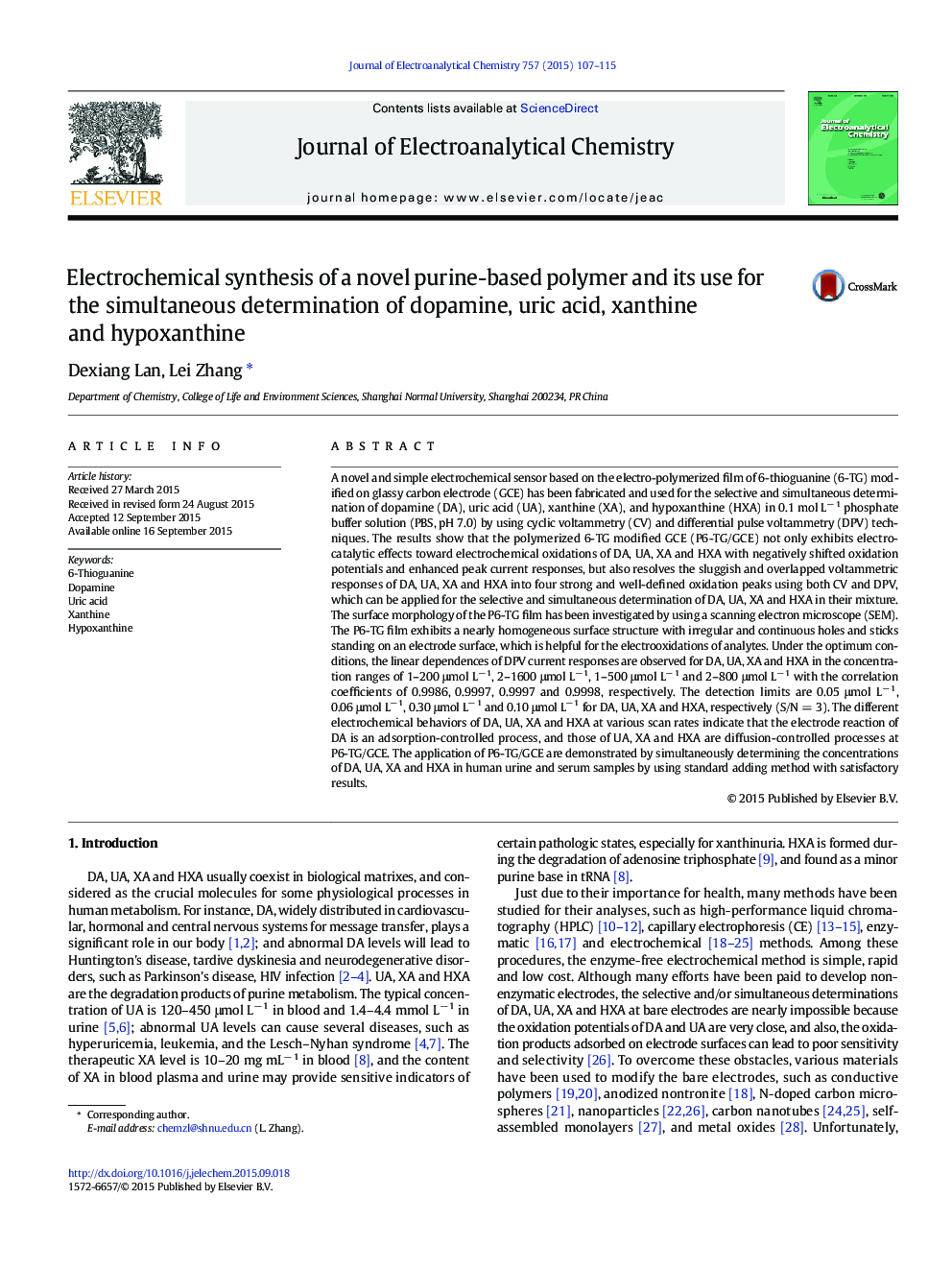| کد مقاله | کد نشریه | سال انتشار | مقاله انگلیسی | نسخه تمام متن |
|---|---|---|---|---|
| 218210 | 463188 | 2015 | 9 صفحه PDF | دانلود رایگان |
• A poly(6-thioguanine) film modified glassy carbon electrode (P6-TG/GCE) had been fabricated.
• P6-TG/GCE showed catalytic activities toward the electro-oxidations of DA, UA, XA and HXA.
• P6-TG/GCE could separate the overlapped oxidation waves of DA, UA, XA and HXA into four anodic peaks.
• P6-TG/GCE could be used for the simultaneous determinations of DA, UA, XA and HXA in real samples.
A novel and simple electrochemical sensor based on the electro-polymerized film of 6-thioguanine (6-TG) modified on glassy carbon electrode (GCE) has been fabricated and used for the selective and simultaneous determination of dopamine (DA), uric acid (UA), xanthine (XA), and hypoxanthine (HXA) in 0.1 mol L− 1 phosphate buffer solution (PBS, pH 7.0) by using cyclic voltammetry (CV) and differential pulse voltammetry (DPV) techniques. The results show that the polymerized 6-TG modified GCE (P6-TG/GCE) not only exhibits electro-catalytic effects toward electrochemical oxidations of DA, UA, XA and HXA with negatively shifted oxidation potentials and enhanced peak current responses, but also resolves the sluggish and overlapped voltammetric responses of DA, UA, XA and HXA into four strong and well-defined oxidation peaks using both CV and DPV, which can be applied for the selective and simultaneous determination of DA, UA, XA and HXA in their mixture. The surface morphology of the P6-TG film has been investigated by using a scanning electron microscope (SEM). The P6-TG film exhibits a nearly homogeneous surface structure with irregular and continuous holes and sticks standing on an electrode surface, which is helpful for the electrooxidations of analytes. Under the optimum conditions, the linear dependences of DPV current responses are observed for DA, UA, XA and HXA in the concentration ranges of 1–200 μmol L− 1, 2–1600 μmol L− 1, 1–500 μmol L− 1 and 2–800 μmol L− 1 with the correlation coefficients of 0.9986, 0.9997, 0.9997 and 0.9998, respectively. The detection limits are 0.05 μmol L− 1, 0.06 μmol L− 1, 0.30 μmol L− 1 and 0.10 μmol L− 1 for DA, UA, XA and HXA, respectively (S/N = 3). The different electrochemical behaviors of DA, UA, XA and HXA at various scan rates indicate that the electrode reaction of DA is an adsorption-controlled process, and those of UA, XA and HXA are diffusion-controlled processes at P6-TG/GCE. The application of P6-TG/GCE are demonstrated by simultaneously determining the concentrations of DA, UA, XA and HXA in human urine and serum samples by using standard adding method with satisfactory results.
Journal: Journal of Electroanalytical Chemistry - Volume 757, 15 November 2015, Pages 107–115
